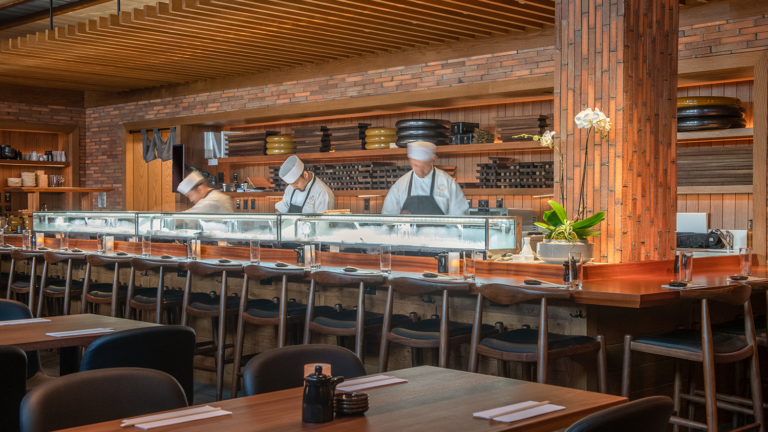Sushi as you wish — actually, as the chef wishes, but it’s all good
Umami Omakase delivers extraordinary joy and value for money.

Our restaurant reviews are part of a series of conversations we’re developing to help you save time and stay informed on what’s happening in the city. Be sure to sign up to receive the latest on the city’s food scene.
If you’re old enough to have memories from the 20th century, you may wincingly recall dad jokes that sneered at sushi: “Haw-haw, I don’t eat bait!” How far we’ve come, sushi now enjoying such wide-ranging popularity that you can get a boxed assortment for six bucks at Stop & Shop, or drop $400 a head at O Ya, Boston’s costliest restaurant. I’ve always leaned toward quality versions of the omakase format, in which the chef selects a progression of courses for you, but that approach often features the rarest items and choicest cuts available that day, with a scary tab to match.
So you’re likelier to find me enjoying the storied, mid-priced omakase at Café Sushi than at swish entrants like Oishii, Pabu, or Zuma. The South End’s No Relation is another relatively modest charmer I frequent for its high quality-to-price ratio. Thus I’m elated to report on the debut of another outstanding option in this tier: Umami Omakase, a pocket-sized place in North Cambridge with exactly two menu choices: “The Experience,” a 15-course omakase ($98, weeknights only) and the swankier 18-course “Umami Omakase” ($138).

Toro uchi with black truffle
“That’s your idea of value?” you may ask. Yup, and let me tell you why. Chef Gary Lei (ex-Uni) serves up impeccably fresh, enticing exotica from distant oceans as well as superb local species. His knife-work is exacting, his rice-seasoning game on point, his flavors galloping from insistent simplicity to fascinating complexity. And every diner gets to sit at his 16-seat bar — another 24 dining-room seats await future waitstaff and kitchen hiring — while he and his lieutenants slice and torch and roll everything before your eyes, their work embellished with humbly passionate, explanatory narration. The price includes dinner and a show.
Umami also does things I wish the posher places would, like keeping the pace brisk (a small course every nine or ten minutes, enough to keep you tantalized but not starving) and skipping the hard upsell on sake. The room, with its stark white walls, blonde woods, Edison-bulb pendants, and lovely illuminated stained-glass ceiling is austere enough to suggest that most of the money is going onto your plate. Lei neatly alternates more traditional dishes with creative tweezery: not every course is high art, yet there are no Instagrammable-but-insipid duds, either.

Hiramasa (kingfish) with pickled chili prawn, dried chili hair, fried garlic, and soy sauce
While I must note that the menu changes frequently, the shorter omakase on one visit starts with a bowl of tender Manila clams sautéed in sake/miso/butter sauce and set in miso broth with enoki and scallions. Up next: sashimi of local yellowtail kingfish (hiramasa) with pickled chili, pickled plum, chili threads and the aromatic citrus/seaweed/sesame/chili blend togarashi, a favored adornment here. Then comes a pretty and fiercely-flavored composed raw oyster with lime-and-chili-charged leche de tigre foam, caviar and black salt, then sashimi of New Zealand king salmon set atop a painterly spatter of plum sauce and bedecked with matcha salt, pomegranate seeds, fried shallot, and a crown of microgreens. The middle sequence consists of single pieces of nigiri, starting with local sea bass (suzuki) seasoned with soy sauce and mirin and accented with red onion, then Japanese torched red snapper (madai) sprinkled with grated egg yolk and scallion.
The run of nigiri pauses mid-point for a showstopper, a sensational bowl of savory egg custard (chawanmushi) dolloped with snow crab and seasoned with dashi, Himalayan salt, sesame oil and scallions, hiding a sweet bay scallop at the bottom and served at an unusually hot temperature to novel and thrilling effect. Housemade pickled ginger slices are proffered for palate-cleansing. Nigiri resumes with jack mackerel (shima aji) topped with aji amarillo salsa and scallion, trailed by torched shrimp (ebi) smacked with bubbly flying fish roe (tobiko), and torched arctic char (iwana) spiked with Chinese spicy oil and sporting an airy poof of tempura-style shredded taro.

Mirugai (geoduck) with yuzu kosho powder
By the home stretch, what may not sound like a lot of food starts to feel filling, satiety accumulating with all that delectable richness and sensory variety. A carmine slab of pristine, fatty raw tuna (chutoro) arrives capped with delicate Maine sea urchin (uni) tartare. Maki generously laden with lightly mayo-dressed king crab is followed by the kaleidoscopically-flavored foie gras pound cake. It’s basted in duck-liver fat, set atop a vibrant swirl of aji amarillo sauce and jazzily clad in apple/fig/bacon compote, black salt, butter powder, chives, and fried garlic. The chef then carefully hands over a hefty, loose nori wrap (temaki) of meaty, sweet-glazed grilled eel (unagi) with rice and fried shallot. The finale of wobbly yuzu panna cotta piles up layers of mango-coconut geleé, whipped cream, desiccated coconut, and a lacey spun-sugar decoration. We’re done. Phew! And whoa!

Langoustine with yuzu, tobiko, and caviar
The Umami Omakase features variations on several of The Experience’s plates (notably with funkier seafood selections), more luxury ingredients, and three more courses, all stunners. On another visit, the added enchanters include the uni spoon: creamy Hokkaido sea urchin, briny caviar, raw quail egg and chives, a single dazzling mouthful to slowly savor. Another is a winsome little cooked langoustine peering up from under a shawl of tobiko and caviar. Yet another features a dramatic modernist-cuisine flourish: marrow bone served under glass that when raised releases a cloud of hickory-wood smoke, revealing sous-vide marrow with butter, sake-soaked mushrooms, caramelized onions, seared short rib, and fried garlic, its flavors suggesting the planet’s most deluxe steak bomb. (The panna cotta boasts a similar showy fillip of dry-ice fog.) The nigiris get more outlandish: one includes Seattle geoduck, a monstrous shore clam I don’t recommend you Google but is quite delicious and appealing when sliced thin and flecked with grated yuzu. Others feature beautifully oily, strong-flavored fishes like Japanese jack mackerel (shima aji), pungent Spanish mackerel, and crunchily torched, silvery edged Japanese barracuda (kamasu). The chutoro/toro course gets upgraded with even fattier Turkish otoro. The maki course inspires awe with real Japanese A5 wagyu beef — absurdly tender, crazily finely marbled, profoundly beefy — with spicy mayo and a quail-egg-yolk topper. You’ll be staggered and stuffed at the finish line (no Fernet-Branca for relief here, alas) but not feel at all cheated by the upcharge.

A5 wagyu beef with lemon zest, truffle sauce, and wagyu powder
Sake sets ($30 for three, $40 for four) offer the ease of staff-chosen pairings, but Set B stumbles one night with the too-early inclusion of Yuagari Yuzushu, a sweetish oddity with enough added yuzu juice to recall limoncello, a dessert-y mismatch. I recommend sticking to crisp sakes like the Kasumi Tsuru Kimoto Extra Dry ($36 for 300 ml) or mild Japanese rice lagers like Orion ($8): they’re less-intrusive companions to the food’s sublime flavors. There are also seven nice-priced bottles of wine ($40-$55, six by the glass, $12-$15). Servers patrol the room to keep the drinks and banter flowing; they’re all winningly helpful, attentive, and enthusiastic. With few seatings per night, reservations (via Yelp) are essential.
Umami’s prices may strike some as extravagant, but I’ll argue that it’s rare to find the kind of gorgeous presentations, peerless ingredients, refined skills, and idiosyncratic vision that Lei and his talented crew deliver. I’ll happily trade two or three cheaper, less-inspired dinners for one of these, and favorably stack the Umami Omakase experience up against the city’s much snootier and pricier competitors.
Umami Omakase; 2372 Massachusetts Ave., Cambridge; Tuesdays–Sundays from 5 p.m.–10 p.m., umamiomakase.com

Chefs prepare langoustine with yuzu, tobiko, and caviar

Kitchen prep at Umami

Umami’s open kitchen








Conversation
This discussion has ended. Please join elsewhere on Boston.com